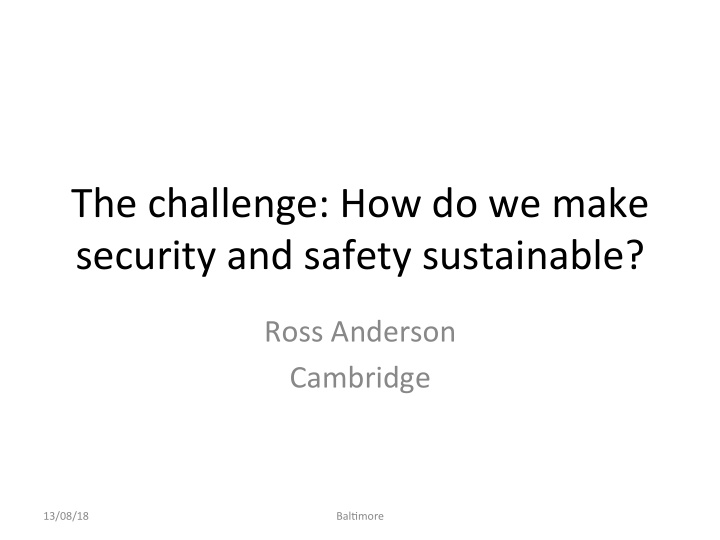



The challenge: How do we make security and safety sustainable? Ross Anderson Cambridge 13/08/18 Bal>more
How does IoT change safety? • The EU regulates safety of all sorts of devices • They asked Éireann LevereJ, Richard Clayton and me to examine what IoT means for this • Once there’s soOware everywhere, safety and security get entangled • How will we have to update safety regula>on (and safety regulators) to cope? • We studied cars, medical devices and grid equipment but the lessons are much broader 13/08/18 Bal>more
The Big Challenge • Established non-IT industries usually have a sta>c approach – pre-market tes>ng with standards that change slowly if at all • The >me constant is typically a decade • When malicious adversaries can scale bugs into aJacks, industries need a dynamic approach with patching, as in IT • The >me constant is then typically a month 13/08/18 Bal>more
Broad ques>ons include… • Who will inves>gate incidents, and to whom will they be reported? • How do we embed responsible disclosure? • How do we bring safety engineers and security engineers together? • Will regulators all need security engineers? • How do we prevent abusive lock-in? Note the US DMCA exemp>on to repair tractors … 13/08/18 Bal>more
Policy recommenda>ons included • Pushing vendors to ensure that products can be patched if need be • Requiring a secure development lifecycle with vulnerability management (ISO 29174, 30111)? • Crea>ng a European Security Engineering Agency to support policymakers (now: ENISA) • Extending the Product Liability Direc>ve to services • Upda>ng NIS Direc>ve to report breaches and vulnerabili>es to safety regulators and users 13/08/18 Bal>more
The punch line • Phones, laptops: patch them monthly, but make them obsolete quickly so you don’t have to support 100 different models 13/08/18 Bal>more
The punch line • Phones, laptops: patch them monthly, but make them obsolete quickly so you don’t have to support 100 different models • Cars, medical devices: we test them to death before release, but don’t connect them to the Internet, and almost never patch 13/08/18 Bal>more
The punch line • Phones, laptops: patch them monthly, but make them obsolete quickly so you don’t have to support 100 different models • Cars, medical devices: we test them to death before release, but don’t connect them to the Internet, and almost never patch • So what happens to support costs now we’re star>ng to patch cars? 13/08/18 Bal>more
Implica>ons for R&D • Research topics to support 20-year patching Include a more stable and powerful toolchain • Crypto teaches how complex this can be • Cars teach: how do we sustain all the test environments? • Control systems teach: can small changes to the architecture limit what you have to patch? • Android teaches: how do we mo>vate OEMs to patch products they no longer sell? 13/08/18 Bal>more
Implica>ons for research and teaching • Since 2016–7 I’ve been teaching safety and security together in the same course to first- year undergraduates • We’re star>ng to look at what we can do to make the tool chain more sustainable • For example, can we stop the compiler writers being a subversive fiOh column? • BeJer ways for programmers to communicate and document intent might help 13/08/18 Bal>more
The grand challenge for research • If the durable goods we’re designing today are s>ll working in 2037 then things must change • Computer science = managing complexity • The history goes through high-level languages, then types, then objects, and tools like git, Jenkins, Coverity … • What else will be needed for sustainable compu>ng once we have soOware in just about everything? 13/08/18 Bal>more
More … • Our papers “Making security sustainable” and “Standardisa>on and Cer>fica>on in the Internet of Things” are on my web page hJp://www.cl.cam.ac.uk/~rja14/ • Or see “When Safety and Security Become One” on our blog hJps://www.lightbluetouchpaper.org which also has a couple of videos 13/08/18 Bal>more
Recommend
More recommend